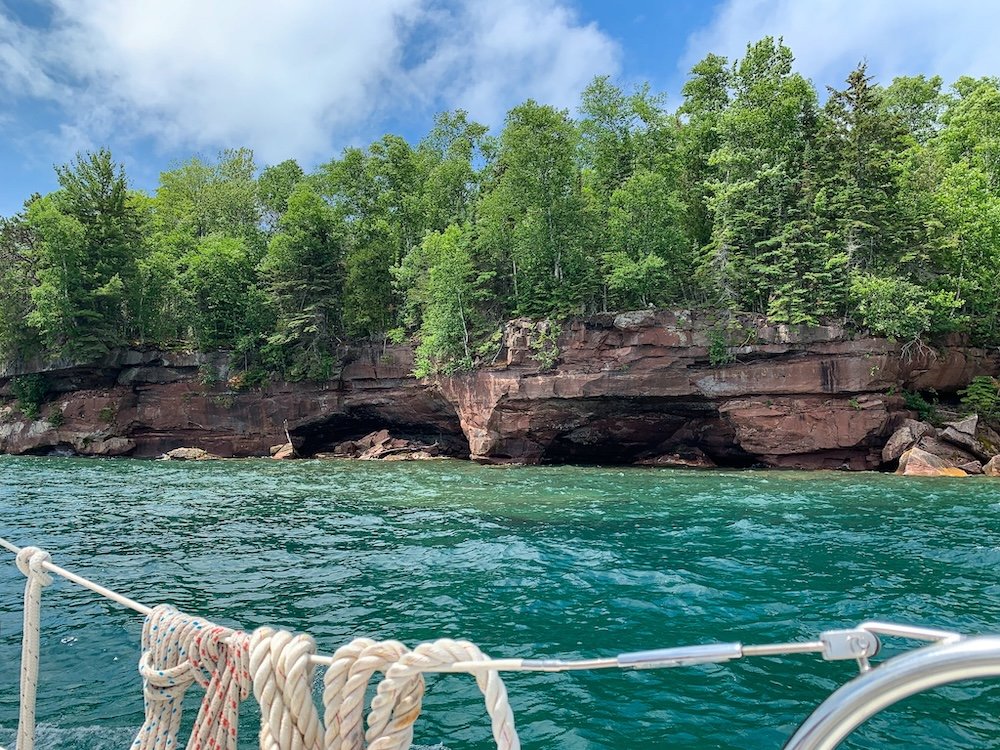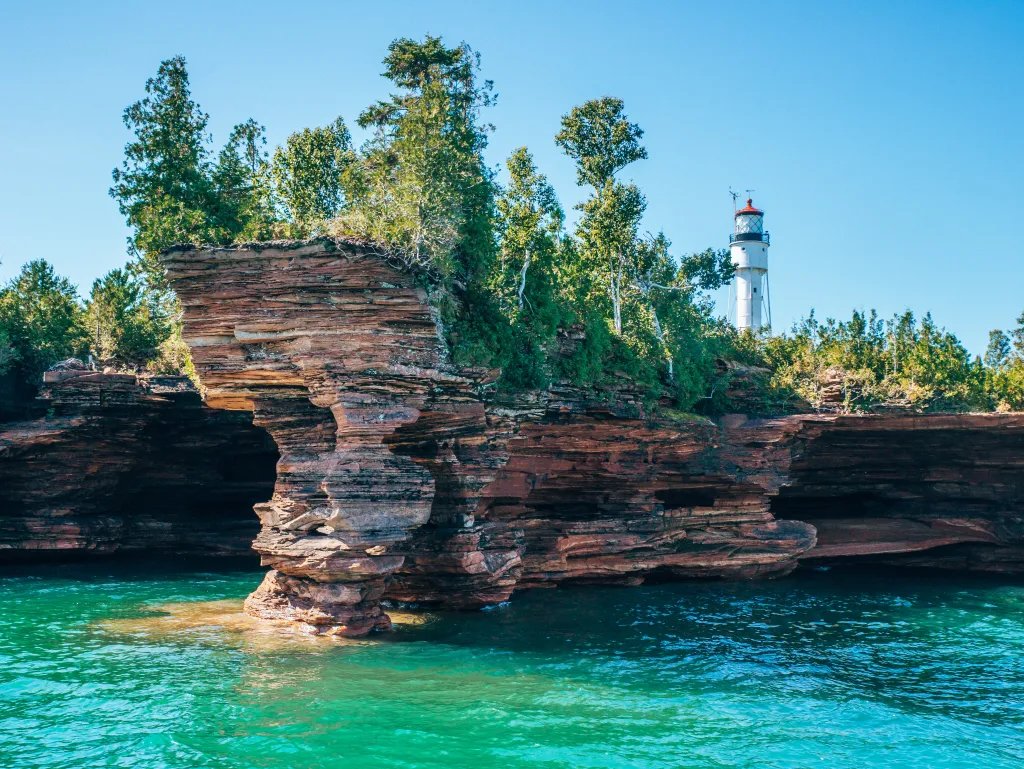
Nestled in the waters of Lake Superior, the Apostle Islands are a breathtaking archipelago of 22 islands off the northern coast of Wisconsin.
Known for their rugged beauty and pristine environments, the islands offer a natural sanctuary that attracts adventurers and nature enthusiasts alike.
The Apostle Islands are not only a testament to the raw, untamed beauty of Wisconsin but also a hub for a wide array of recreational activities—from kayaking through sea caves to hiking along scenic trails.
As a key tourist destination, the Apostle Islands play a vital role in Wisconsin’s tourism industry.
They draw visitors from across the globe, eager to explore their unique landscapes and rich history.
The islands are renowned for their historic lighthouses, vibrant maritime culture, and the diverse wildlife that resides within the Apostle Islands National Lakeshore.
The significance of the Apostle Islands extends beyond their natural allure, contributing significantly to the local economy and fostering a deeper appreciation for environmental conservation.
In this article, we will embark on a journey through the top 20 must-see spots of the Apostle Islands, each offering a unique experience and insight into what makes these islands a must-visit destination.
From the iconic Mainland Sea Caves that display nature’s artistry to the serene landscapes of Little Sand Bay, each spot has been carefully selected to enhance your visit and create lasting memories.
Whether you are seeking solitude in a remote island setting or adventure in outdoor activities, the Apostle Islands offer something for everyone.
Geography and History of the Apostle Islands
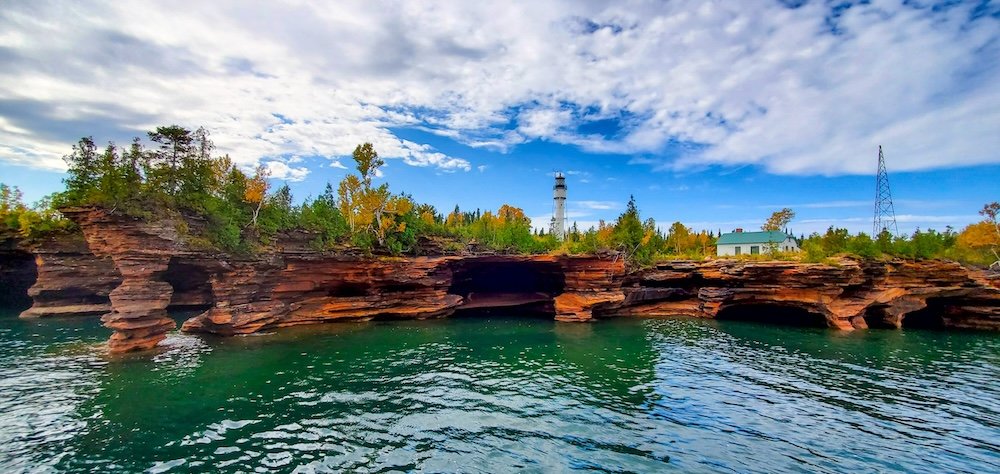
The Apostle Islands are located in Lake Superior, the largest of the Great Lakes of North America.
This archipelago consists of 22 islands that span the southern shore of Lake Superior, near Bayfield, Wisconsin.
The varying sizes and formations of these islands are the result of geological forces over thousands of years, including glaciation, which has shaped their unique landscapes.
These islands boast a combination of sandy shores, rugged cliffs, and dense forests, providing a complex ecosystem that supports a variety of wildlife.
The history of the Apostle Islands is as rich and varied as its landscapes.
Native American tribes, particularly the Ojibwe (Chippewa), have inhabited these islands for centuries.
The islands were used primarily for fishing and as spiritual places.
The name “Apostle Islands” is believed to have been given by Jesuit missionaries in the 17th century, though the islands do not correspond in number to the apostles in the Bible.
The 19th and 20th centuries saw European settlers arrive, bringing with them the logging, mining, and fishing industries, which significantly altered the landscape and local economies.
Recognizing the unique ecological and historical significance of the Apostle Islands, efforts to conserve the area gained momentum in the mid-20th century. In 1970, the Apostle Islands National Lakeshore was established by Congress.
This designation has helped protect the natural and cultural resources of the islands.
The National Lakeshore encompasses 21 of the islands and a 12-mile stretch of mainland shore, protecting it from further industrial development and preserving its biodiversity.
Today, the Apostle Islands National Lakeshore serves as a prime example of successful conservation efforts, promoting sustainable tourism and environmental education for all visitors.
Planning Your Visit
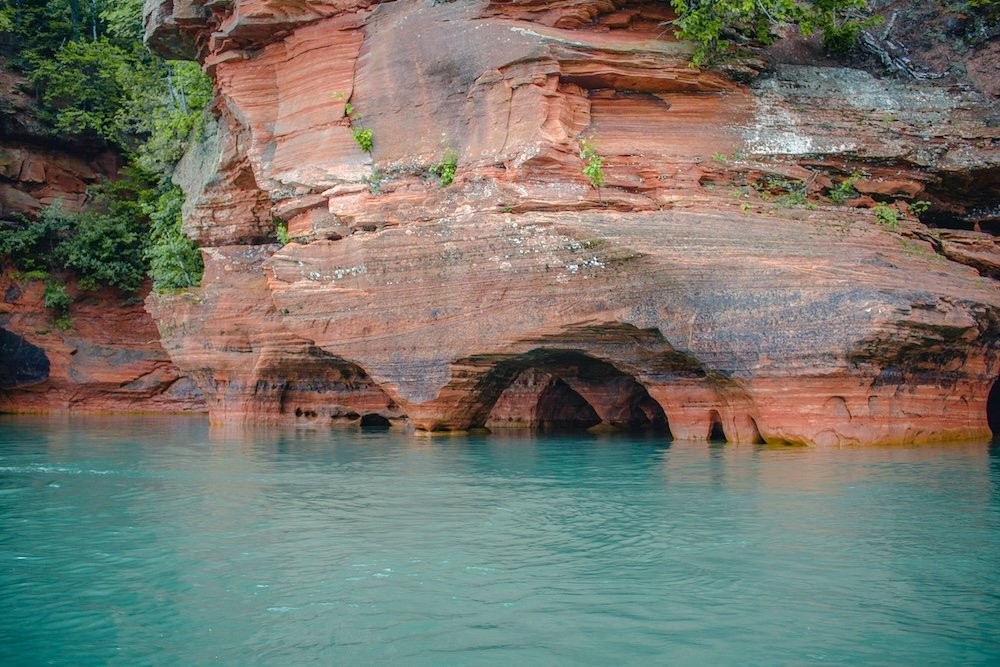
Visiting the Apostle Islands offers different experiences throughout the year, making it a unique destination no matter the season.
The summer months, from June to August, are the most popular due to the warm weather, which is ideal for kayaking, hiking, and camping.
However, if you prefer a quieter visit with fewer tourists, the shoulder seasons—late spring and early fall—are excellent times to explore the islands.
The weather is still pleasant, and the changing colors of fall or the blooming flowers of spring enhance the natural beauty of the area.
Winter also holds its charm, especially for ice fishing, snowshoeing, and viewing the stunning ice formations in the sea caves, though accessibility can be more challenging due to ice and snow.
Transportation Options to and Around the Islands (Ferries, Private Boats, etc.)
Access to the Apostle Islands is primarily through Bayfield, Wisconsin, where visitors can take ferries to several of the islands.
The most frequent ferry routes serve Madeline Island, which is not part of the national lakeshore and is the only island with commercial development.
For the other islands within the Apostle Islands National Lakeshore, private boat tours, water taxis, and kayak rentals are available, offering guided tours and transportation services.
For those who own or rent a private boat, there are docking facilities available on several islands, but it’s important to check local regulations and weather conditions, as Lake Superior is known for its unpredictable weather.
Tips for Sustainable and Responsible Tourism
Sustaining the beauty and integrity of the Apostle Islands is a collective responsibility. Here are some tips to ensure your visit is both enjoyable and environmentally conscious:
- Stick to marked trails and boardwalks to protect native plants and prevent erosion.
- Carry out all trash, and even consider packing out trash you find left by others.
- Use biodegradable products for personal care and cleaning when camping.
- Respect wildlife by keeping a safe distance and not feeding animals to avoid disrupting their natural behaviors.
- Support local businesses by purchasing local products and services, which helps sustain the local economy and reduce transportation-related emissions.
- Educate yourself about the history and ecology of the islands before your visit to enhance your appreciation and understanding of their significance.
1. Mainland Sea Caves
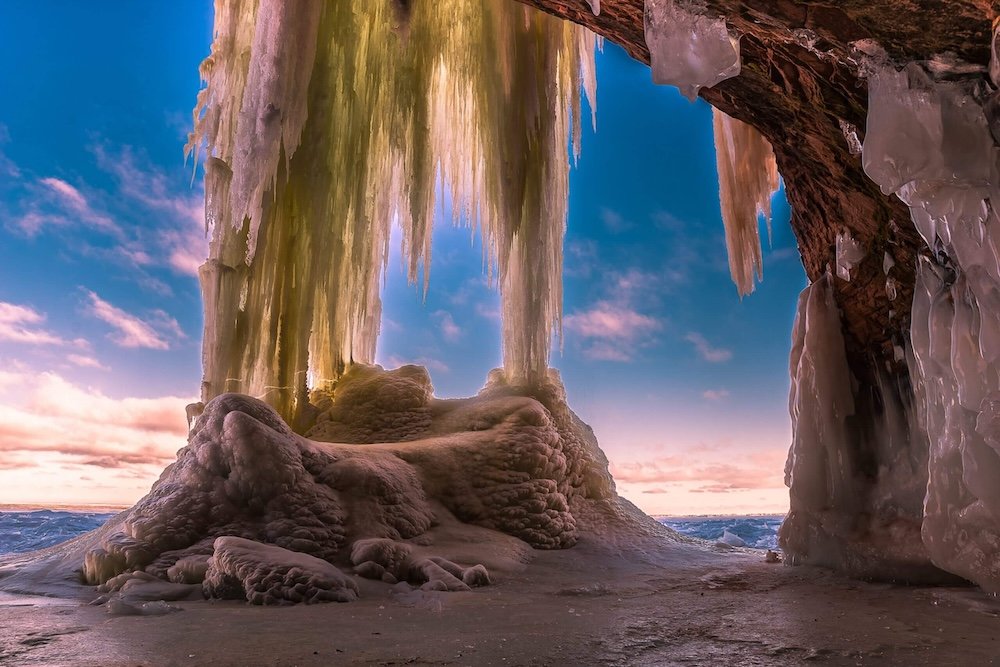
The Mainland Sea Caves of the Apostle Islands are one of the most spectacular natural features of the region.
Located along the shore of the mainland part of the Apostle Islands National Lakeshore, these caves have been formed by the relentless forces of Lake Superior.
Over centuries, the waves have sculpted the sandstone cliffs into intricate patterns of arches, chambers, and narrow passageways, creating a breathtaking display of natural artistry.
The caves are especially stunning in the winter when the lake’s spray coats them in sheets of ice, forming shimmering ice curtains and icicles.
Visiting the Mainland Sea Caves can be an awe-inspiring experience, accessible by different means depending on the season.
During the summer, the caves are best explored by kayak, with several local outfitters offering guided tours that ensure safety and provide historical and ecological insights.
These tours typically launch from Meyers Beach, where visitors can also find parking and basic amenities.
In the winter, when conditions permit, the caves transform into a frozen wonderland accessible by foot or snowshoe via a marked trail starting from Meyers Beach.
The ice formations and frozen waterfalls inside the caves present a magical winter landscape, drawing photographers and nature enthusiasts from all over.
Regardless of the season, visitors should check the local weather and ice conditions before planning their trip.
The National Park Service provides updates on accessibility and safety conditions, which is crucial for ensuring a safe and enjoyable visit.
Whether you are paddling in the summer or walking in the winter, the Mainland Sea Caves offer a unique adventure that highlights the dynamic beauty of the Apostle Islands.
2. Devils Island
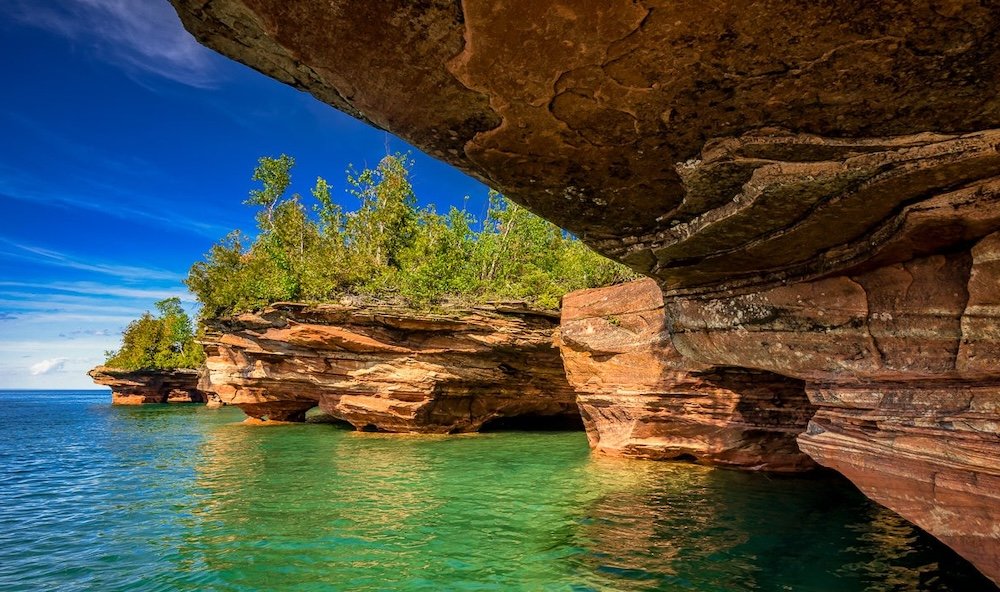
Devils Island, the northernmost of the Apostle Islands, is a remote and mystic place that epitomizes the wild, untouched spirit of Lake Superior.
This small island features rugged coastlines and dense forests, providing a secluded getaway for those looking to immerse themselves in nature.
Its isolation contributes to its untouched allure, making it a prime spot for adventurers seeking tranquility away from the bustling tourist paths.
Notable for Its Lighthouse and Sea Caves
Devils Island is renowned for two major attractions: its historic lighthouse and the remarkable sea caves.
The Devils Island Lighthouse, standing since 1891, serves as a beacon of maritime history. This lighthouse is one of the several historic lighthouses in the Apostle Islands, but it is particularly famed for its picturesque setting and the role it played in navigating the treacherous waters of Lake Superior. The lighthouse has been automated but continues to operate, with tours typically available during the summer months. Its white tower and red roof make it a striking feature against the backdrop of the island’s natural scenery.
The Sea Caves of Devils Island are another spectacular feature, echoing the geological beauty found at the Mainland Sea Caves but with their own distinct character. The caves here are accessible by kayak or boat, allowing visitors to navigate through arches and tunnels carved by wave action. The interior walls of these caves are lined with colorful streaks formed by mineral deposits, and the sound of the lake echoing through these natural halls creates an almost otherworldly experience.
Visiting Devils Island requires a bit more planning due to its remote location. Access is typically by private boat or kayak, with occasional water taxi services.
Weather conditions can greatly affect access, so it’s advisable to check with local tour operators for safe travel arrangements and guided tours, which can enhance the experience with expert knowledge of the island’s history and natural features.
3. Sand Island
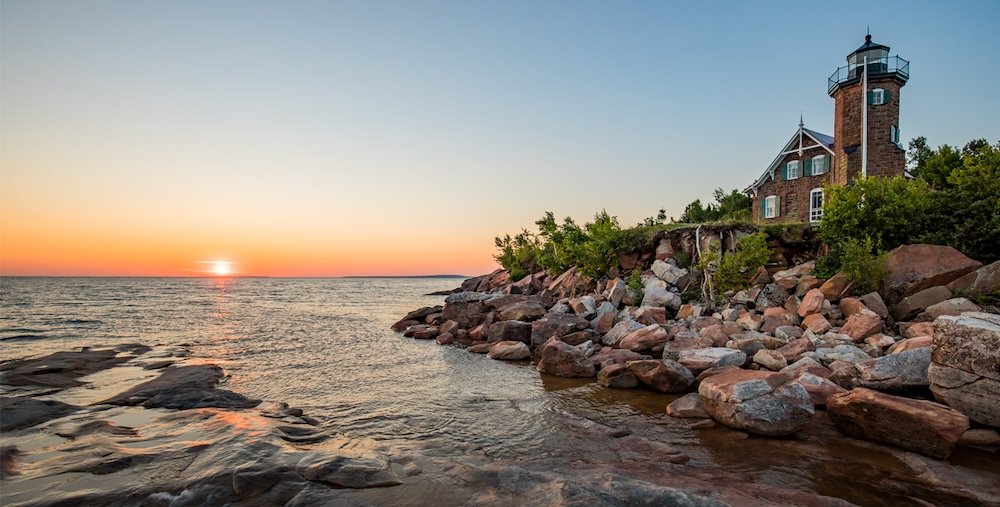
Sand Island, one of the more accessible and enchanting islands within the Apostle Islands National Lakeshore, offers visitors a perfect blend of natural beauty and historical intrigue.
As its name suggests, Sand Island boasts some of the finest sandy beaches in the archipelago, making it a favorite for beachgoers and families.
The island’s lush forested interior and scenic shoreline provide a picturesque backdrop for a variety of outdoor activities.
Known for Its Sandy Beaches and Historical Sites
Sandy Beaches: Sand Island’s beaches are among the most inviting in the Apostle Islands. The soft, white sands contrast beautifully with the clear blue waters of Lake Superior, creating ideal spots for sunbathing, picnicking, and gentle swimming in warmer months. The relatively calm waters near the beaches also make this area perfect for kayaking and stand-up paddleboarding.
Historical Sites: Beyond its natural allure, Sand Island is steeped in history. The island is home to the historic Sand Island Lighthouse, built in 1881, which played a crucial role in guiding ships through the West Channel of Lake Superior. Although the lighthouse is no longer operational, it remains a significant cultural landmark and is open for tours during the summer months. The island also features remnants of early 20th-century farming settlements and a small network of trails that lead visitors through old growth forests to abandoned stone structures, offering a glimpse into the island’s past life.
Access to Sand Island is primarily by boat, with options ranging from private charters to guided tours. Kayakers often include Sand Island as a key stop on their paddling trips around the Apostle Islands.
For those looking to stay overnight, there are designated campsites available, which provide a rustic and immersive island experience.
4. Madeline Island
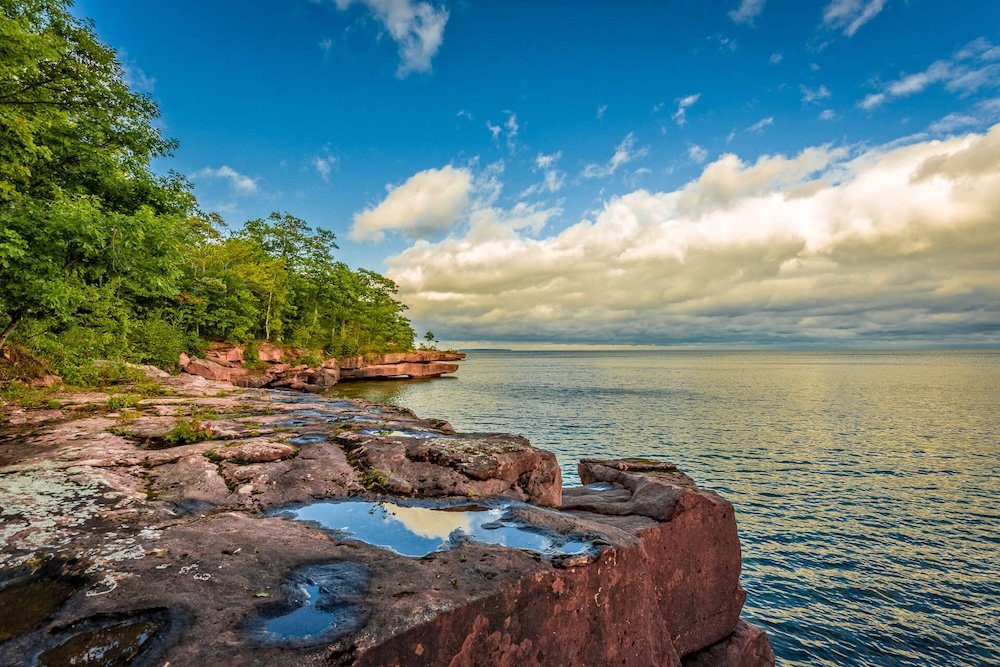
Madeline Island, the largest of the Apostle Islands, stands out as the only one not included in the Apostle Islands National Lakeshore.
It serves as the commercial and cultural hub of the archipelago, with a vibrant community and more developed amenities than its sister islands.
Unlike the mostly uninhabited and protected islands surrounding it, Madeline Island buzzes with life year-round, offering a unique blend of natural beauty and community activities.
The Only Inhabited Island, Featuring Cultural and Community Events
Inhabited and Accessible: As the only inhabited island in the Apostle Islands, Madeline Island has a permanent population and welcomes visitors with a variety of services including restaurants, shops, and accommodations. The island is accessible by ferry from Bayfield or, in the winter months, via an ice road when conditions permit. This easy accessibility makes it a popular starting point for exploring the Apostle Islands.
Cultural and Community Events: Madeline Island’s rich history and active community life are best showcased through its numerous cultural and community events that draw both locals and tourists. The Madeline Island Museum, for example, offers insights into the area’s history from the early Native American inhabitants to European fur traders and settlers. Additionally, the island hosts various annual events such as the Madeline Island Marathon, the Fourth of July parade, and the Music Camp, which features performances and workshops. Art and craft workshops, guided historical tours, and naturalist-led programs also occur throughout the year, celebrating the island’s cultural heritage and natural environment.
Furthermore, La Pointe, the main town on Madeline Island, is a quaint and picturesque spot that encapsulates the island’s charm and serves as the focal point for many of its cultural activities.
Here, visitors can enjoy local art galleries, dine at restaurants featuring local cuisine, and participate in community events that offer a warm welcome to all who visit.
5. Stockton Island
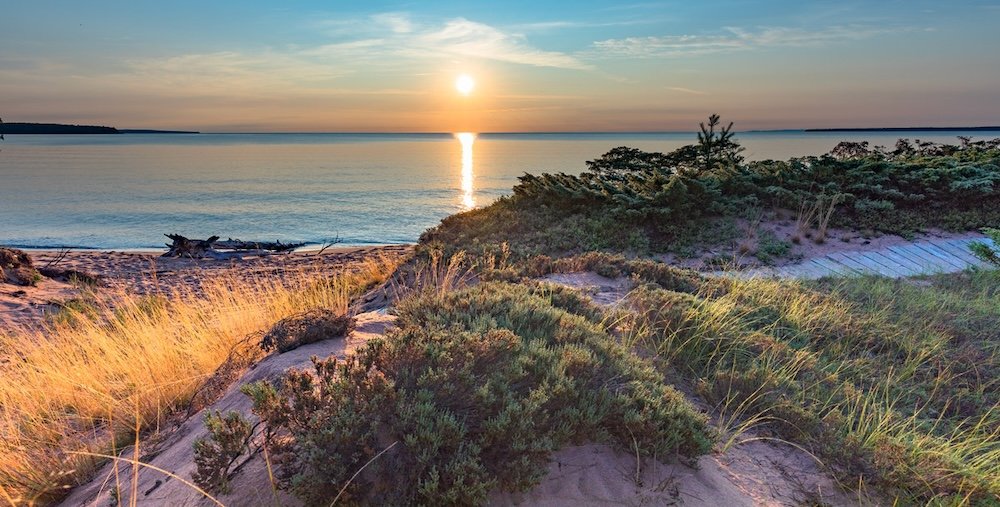
Stockton Island is known for its ecological diversity and is one of the largest islands within the Apostle Islands National Lakeshore.
Famous for its clear waters, expansive sandy beaches, and lush greenery, Stockton Island offers a serene escape into nature.
Its varied landscapes provide habitats for a wide range of wildlife, making it a prime spot for nature lovers and environmental enthusiasts.
Best for Hiking and Exploring Unique Sand Spits
Hiking Opportunities: Stockton Island boasts an extensive network of trails that traverse diverse terrains from dense forests to sandy shores. The trails offer hikers scenic views of the island’s interior and coastlines, with well-marked paths suitable for varying levels of experience. One of the most popular trails is the loop around Anderson Point, which offers breathtaking views of Lake Superior and the chance to spot local wildlife, including the island’s famous black bears and numerous bird species.
Unique Sand Spits: Among Stockton Island’s distinctive features are its remarkable sand spits. These naturally occurring sandy extensions jut out into Lake Superior and form unique shapes that change with wind and water currents. The Julian Bay spit is particularly famous for its “singing sands,” a rare phenomenon where the sand produces squeaking sounds when walked upon due to its high silica content. This area is not only a wonder for geologists but also a delight for visitors looking to experience one of nature’s curiosities.
Access to Stockton Island is primarily by boat, with options available from local tour operators in Bayfield.
The island hosts several campsites that allow visitors to immerse themselves fully in its natural beauty.
Whether you’re an avid hiker or just looking to relax on pristine beaches, Stockton Island provides an unmatched natural retreat.
6. Raspberry Island
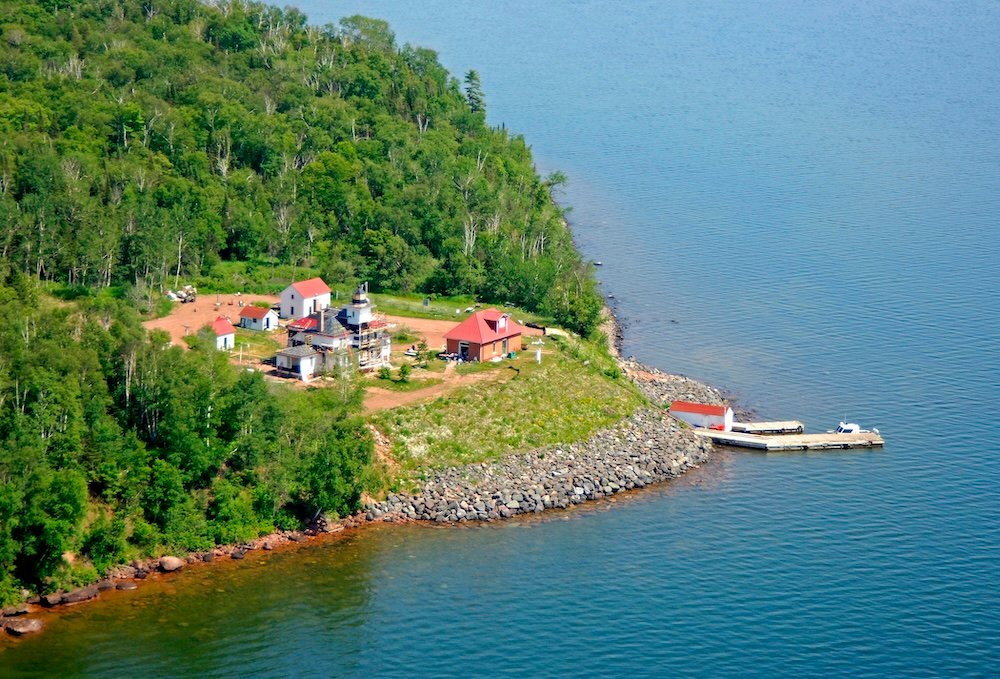
Raspberry Island, often referred to as the “jewel of the Apostle Islands,” is renowned for its charming beauty and manageable size, making it a favorite among day-trippers and those looking for a less strenuous visit.
The island’s lush, verdant landscape and well-maintained trails offer a peaceful retreat with stunning views of Lake Superior.
Raspberry Island’s small size contributes to its intimate feel, allowing visitors to easily explore its attractions within a short time.
Famous for Its Picturesque Lighthouse
Raspberry Island Lighthouse: The centerpiece of Raspberry Island is its historic lighthouse, known as the Raspberry Island Lighthouse. This beautifully preserved structure, dating back to 1862, is one of the few remaining wood-framed lighthouses on Lake Superior. The lighthouse has been meticulously restored to reflect its early 20th-century condition, providing a glimpse into the life of a lighthouse keeper through guided tours that detail the history and operations of this critical maritime facility.
The lighthouse not only serves as a historical monument but also offers panoramic views of the surrounding area, making it a must-visit for photographers and history enthusiasts alike. The grounds around the lighthouse are well-kept, with gardens and picnic areas where visitors can relax and enjoy the serene environment.
Access and Activities: Raspberry Island is accessible by private boat or through scheduled tours from Bayfield, which often include a guided tour of the lighthouse. The island’s docking facilities make it convenient for visitors traveling by personal watercraft. Besides exploring the lighthouse, guests can enjoy leisurely walks along the island’s trails or relax by the shoreline, soaking in the peaceful atmosphere and natural beauty.
7. Outer Island
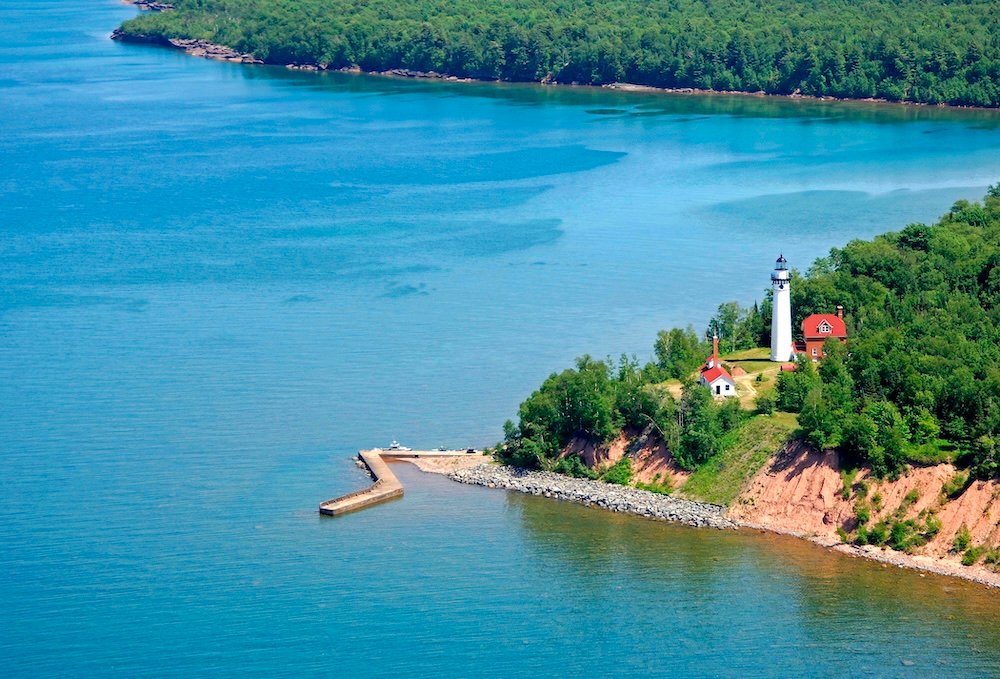
Outer Island stands as one of the most remote and untouched islands in the Apostle Islands chain, offering an unparalleled sense of solitude and natural beauty.
This island is characterized by its rugged terrain, extensive forests, and a long, pristine shoreline that challenges and rewards adventurous visitors.
Outer Island’s isolation makes it less frequented by casual tourists, providing a more intimate experience with nature for those who make the journey.
Known for Its Remote Wilderness and Bird Watching
Remote Wilderness: Outer Island’s remote wilderness is a haven for those seeking to escape the hustle and bustle of daily life. The island features diverse landscapes, including sandy beaches, dense forests, and marshy bogs, all largely untouched by human development. Hiking trails on Outer Island are less trodden and offer rugged, unspoiled scenery that appeals to serious hikers and nature lovers. This isolation not only preserves the ecological integrity of the island but also enhances the experience for visitors looking for a true wilderness adventure.
Bird Watching: For bird enthusiasts, Outer Island is a prime destination. Its varied ecosystems support a wide array of bird species, making it one of the best spots in the Apostle Islands for bird watching. The island serves as a critical stopover for migratory birds and is home to nesting pairs of bald eagles, peregrine falcons, and other rare birds. The lack of crowds and low noise pollution contribute to ideal bird-watching conditions, where one can observe these magnificent creatures in their natural habitat without disturbance.
Accessing Outer Island: Due to its remote location, accessing Outer Island can be challenging. It is best reached by private boat, and visitors should be well-prepared with supplies and safety equipment. Weather conditions on Lake Superior can change rapidly, and it’s advisable to check forecasts and seek local advice before setting out. For those who are not seasoned boaters, guided tours that include bird watching and exploration of the island’s unique features are recommended.
8. Meyers Beach
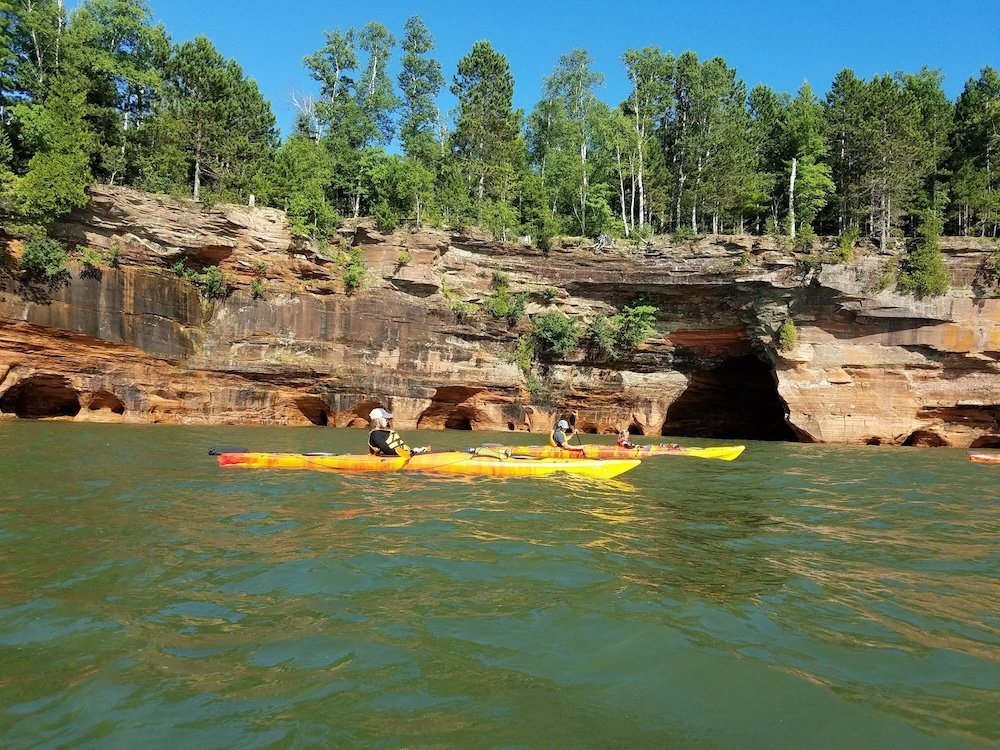
Meyers Beach is a renowned gateway to the Apostle Islands, offering visitors stunning views of Lake Superior and access to one of the most iconic attractions in the area—the Mainland Sea Caves.
Unlike the remote and wild islands, Meyers Beach is easily accessible by car, making it a popular starting point for both day-trippers and adventurers alike.
The beach itself features a long stretch of sand and pebble shoreline, backed by towering pine trees, providing a picturesque setting for a variety of outdoor activities.
Popular Launching Spot for Kayakers
Kayaking Hub: Meyers Beach is especially popular among kayakers due to its proximity to the spectacular sea caves along the mainland coast. These caves are best explored by water, and Meyers Beach offers the perfect launch point for this adventure. Kayakers can paddle along the shoreline, exploring intricate rock formations, hidden caves, and arches created by the erosive powers of Lake Superior. The calm waters near the beach make it suitable for both beginners and experienced kayakers.
Facilities and Access: The beach is well-equipped to handle the influx of visitors it receives, especially during the summer months. There are ample parking spaces, restroom facilities, and picnic areas, making it convenient for visitors planning a full day of activities. Additionally, local outfitters operate from Meyers Beach, offering kayak rentals and guided tours that ensure visitors can safely enjoy their exploration of the sea caves and surrounding areas.
Seasonal Considerations: While summer is the peak season for kayaking from Meyers Beach, the area is also strikingly beautiful in the winter. The frozen landscape offers a different kind of adventure, where visitors can walk along the lakeshore to view the ice formations on the cliffs and caves. However, winter visitors must be prepared for the harsh conditions and ensure they check local ice and weather reports before venturing out.
9. Oak Island

Oak Island is one of the larger islands within the Apostle Islands National Lakeshore, offering a diverse landscape that includes dense hardwood forests, rolling hills, and secluded beaches.
This blend of features makes Oak Island a favorite among those seeking a varied outdoor experience in a relatively compact area.
The island’s secluded nature and abundant natural resources provide a peaceful escape for visitors looking to immerse themselves in the tranquility of the Apostle Islands.
Ideal for Hiking and Camping Enthusiasts
Hiking Opportunities: Oak Island offers several well-maintained trails that cater to hikers of all skill levels. These trails wind through the island’s lush forests and open onto spectacular views of Lake Superior and the surrounding islands. The Island Loop Trail, in particular, is a favorite for its comprehensive tour of the island’s topographical and ecological diversity. Hikers can enjoy sightings of local wildlife, including deer, foxes, and a variety of bird species, along these scenic routes.
Camping Sites: For those who wish to extend their stay and truly connect with nature, Oak Island provides excellent camping opportunities. The island features several rustic campsites that are strategically placed to offer both privacy and stunning natural vistas. These sites are accessible via hiking or boating, with some located right by the lakeshore, allowing campers to fall asleep to the soothing sounds of Lake Superior’s waves.
Access and Amenities: Oak Island is accessible by private boat or water taxi services from nearby Bayfield. While the island offers a back-to-nature experience, it does so with a few basic amenities to ensure visitor comfort, including designated fire rings and toilet facilities at campsites. Visitors are encouraged to practice Leave No Trace principles to preserve the pristine condition of the natural environment.
10. Ironwood Island
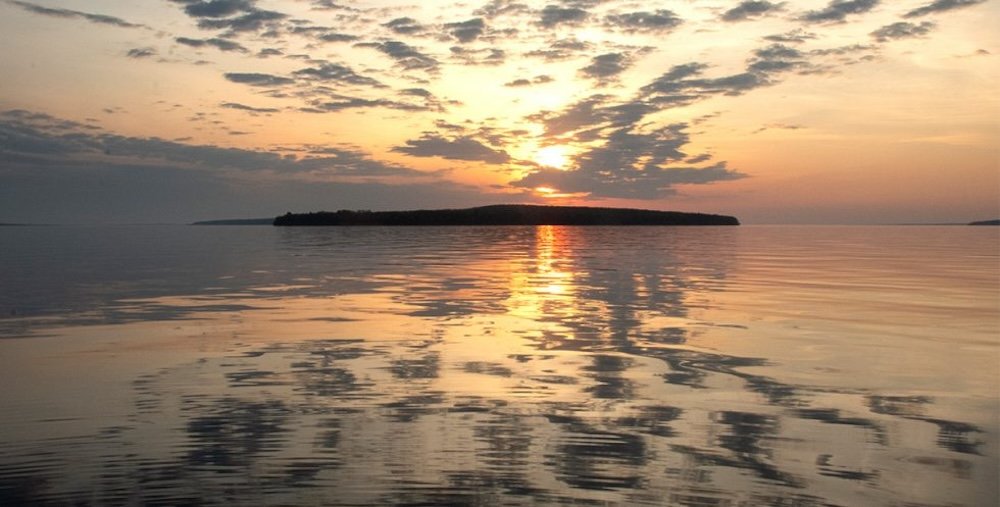
Ironwood Island is a serene and less frequented gem within the Apostle Islands, offering an untouched natural environment that feels worlds away from the hustle and bustle of everyday life.
Known for its rugged terrain and dense forestation, Ironwood Island provides a secluded haven for those looking to disconnect and immerse themselves in nature.
The island’s small size and limited accessibility contribute to its tranquil atmosphere, making it a perfect retreat for solitude seekers and nature lovers alike.
Explore Old-Growth Forests and Secluded Beaches
Old-Growth Forests: Ironwood Island is named for its prominent stands of ironwood trees, but its forests also include other species such as birch, maple, and pine. These old-growth forests are some of the most pristine in the region, offering a canopy of green that supports a diverse ecosystem of flora and fauna. Hiking through these woods, visitors can enjoy the quiet majesty of towering trees and the occasional wildlife sightings, such as birds and small mammals, that make this island their home.
Secluded Beaches: Alongside its forested areas, Ironwood Island features several secluded beaches that are perfect for relaxation and contemplation. These beaches are often empty, providing a private experience of Lake Superior’s rugged coastline. The beaches vary from rocky outcrops to small sandy coves, each offering a unique vantage point to view the sunrise or sunset over the lake.
Accessing Ironwood Island: Ironwood Island’s secluded nature means that access is typically via private boat or kayak, allowing for a more intimate adventure as visitors travel across the open waters of Lake Superior. Due to its remote location, visiting Ironwood Island requires some planning, especially in terms of safety and provisions, as there are no services or facilities available on the island. This isolation makes it an ideal spot for day trips or quiet, short-term camping for those prepared to practice complete leave-no-trace ethics.
11. Cat Island
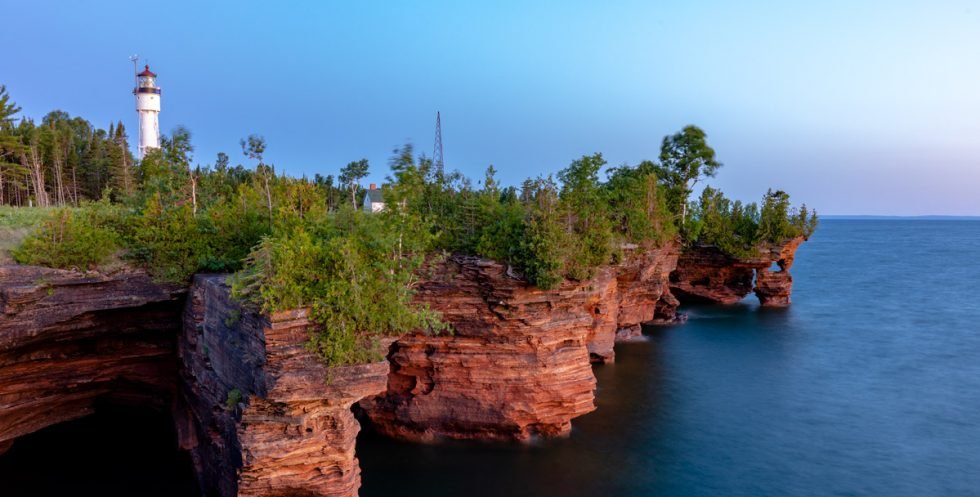
Cat Island, one of the outermost islands in the Apostle Islands archipelago, embodies the wild, untamed spirit of Lake Superior.
This island remains largely undeveloped, offering a raw and rugged landscape that appeals to those who seek a pure wilderness experience.
Cat Island’s remote location and challenging access contribute to its feeling of isolation and serenity, making it a cherished spot for adventurers and solitude seekers.
Known for Its Undeveloped Landscapes and Privacy
Undeveloped Landscapes: The natural environment of Cat Island is characterized by dense forests, wetlands, and long, untouched shorelines. The lack of development has allowed the island’s ecosystems to thrive, providing a sanctuary for wildlife and a living laboratory for nature enthusiasts. Hiking across Cat Island, visitors can encounter a variety of habitats that are increasingly rare in more populated areas. The island’s natural state also offers excellent opportunities for environmental photography and nature study, capturing the essence of the Apostle Islands’ wild beauty.
Privacy: The secluded nature of Cat Island makes it an ideal destination for those looking to escape the crowds and enjoy a more private outdoor experience. The limited access ensures that only those willing to make the effort to reach the island can enjoy its secluded beaches and hidden coves. This privacy makes Cat Island a perfect place for contemplative retreats, artistic inspiration, or simply enjoying the peace of the great outdoors without interruption.
Accessing Cat Island: Reaching Cat Island is best achieved by private boat or kayak, suited for experienced boaters due to the potentially rough waters of Lake Superior and the island’s distance from the mainland. Visitors should be well-prepared with all necessary supplies and safety equipment, as there are no facilities or services on the island. This level of preparation and effort is well rewarded with one of the most undisturbed natural experiences within the Apostle Islands.
12. Bear Island
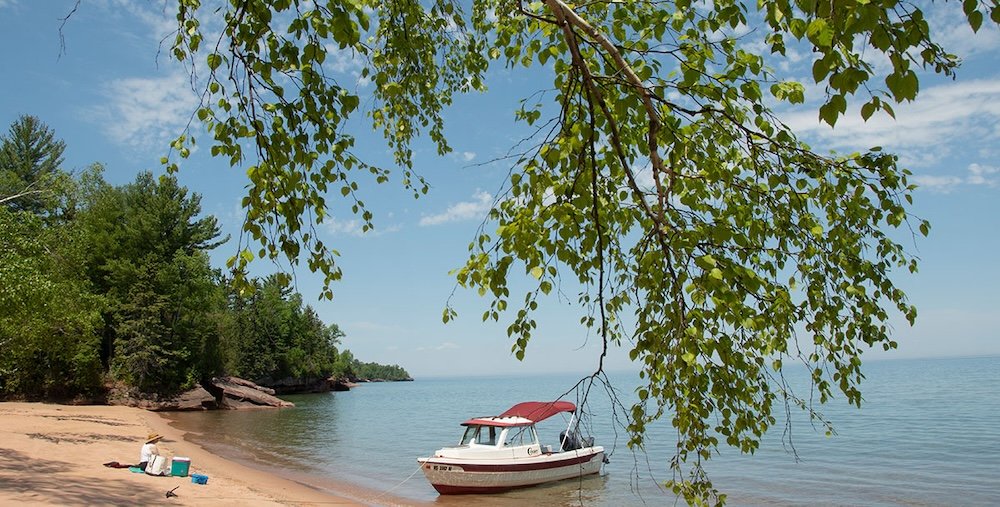
Bear Island is a captivating locale within the Apostle Islands, known for its dense forest cover and relatively undisturbed natural environment.
This modestly sized island offers a quiet retreat from the more frequented tourist spots, making it a sanctuary for wildlife and a haven for those seeking peace and solitude.
The island’s diverse ecosystem supports a variety of plant and animal species, providing an ideal setting for nature walks and wildlife observation.
Cultural Significance and Historical Artifacts
Cultural Significance: Bear Island holds a special place in the cultural history of the Apostle Islands. It has been a site of significance for the Native American communities, particularly the Ojibwe people, who have inhabited the region for centuries. The island was historically used for spiritual practices and as a seasonal camp, with several archaeological sites providing evidence of its long-standing human connections. These sites offer a glimpse into the past lifestyles and traditions of the island’s original inhabitants.
Historical Artifacts: Throughout Bear Island, visitors can find traces of its historical use, from ancient tool-making sites to remnants of early 20th-century cabins. These artifacts tell the story of the island’s evolution from a sacred native land to a resource utilized during the logging boom in the Great Lakes region. Guided tours and educational programs are sometimes available to help visitors understand the historical and cultural layers of the island, enhancing the appreciation of its heritage.
Accessing Bear Island: Access to Bear Island is typically by boat, with options including private charters or personal watercraft from nearby locations. Due to its cultural sensitivity, visitors are encouraged to respect the island’s historical sites and natural resources. This includes following guidelines such as not disturbing artifacts and adhering to established trails to minimize environmental impact.
13. Gull Island
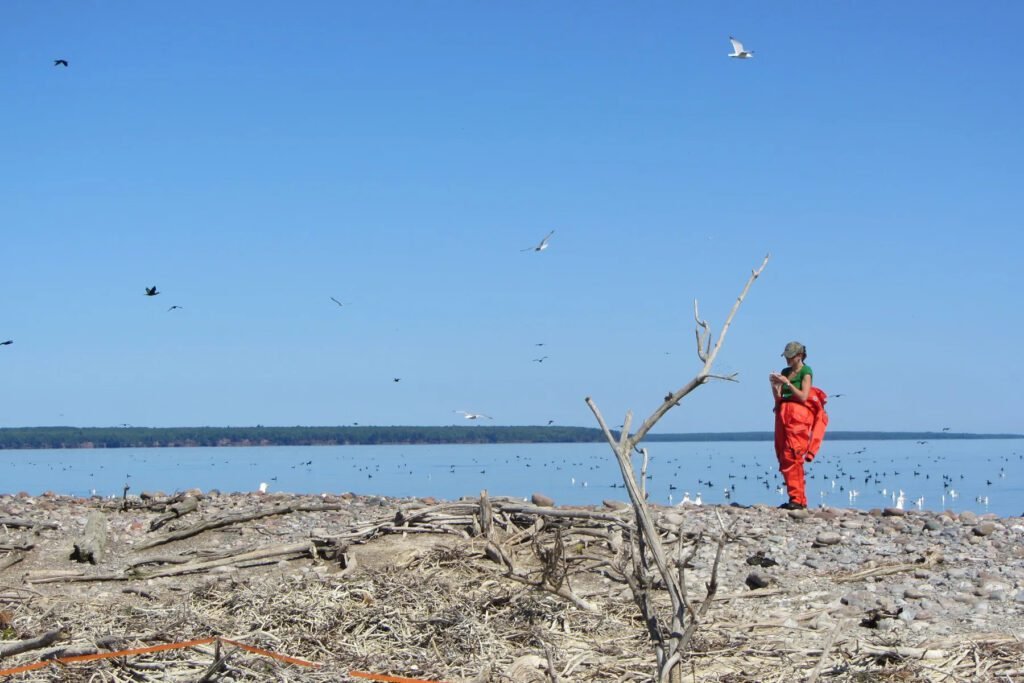
Gull Island is one of the smallest in the Apostle Islands archipelago, yet it stands out as an important ecological site.
This tiny island, often overlooked due to its size and the lack of visitor amenities, plays a crucial role as a protected habitat for bird populations.
The island’s bare, rocky landscape is predominantly covered with small shrubs and grasses, creating ideal nesting grounds for various bird species.
Birdwatching Paradise
Birdwatching Haven: Gull Island is renowned among ornithologists and birdwatching enthusiasts as a sanctuary for numerous bird species, especially colonial nesting birds such as gulls, cormorants, and terns. The island serves as one of the largest breeding grounds in the area, with birds flocking to the island each spring to nest and raise their young. The lack of predators and the isolated environment make it an ideal location for birds to thrive.
Visiting for Birdwatching: Due to its significance as a bird habitat, Gull Island is often subject to access restrictions, especially during the breeding season to prevent disturbance to the nesting birds. Visitors interested in birdwatching are advised to check with the Apostle Islands National Lakeshore authorities for current guidelines and possible viewing opportunities. When access is allowed, it is typically at a distance, either from a boat or a designated viewing area, to ensure minimal impact on the wildlife.
Preservation Efforts: The protection of Gull Island is a priority for conservationists, aiming to maintain its status as a crucial breeding site. Efforts include monitoring bird populations and nesting success, as well as educating the public about the importance of preserving such unique natural habitats. These initiatives help ensure that Gull Island continues to be a thriving haven for its avian residents.
14. Eagle Island
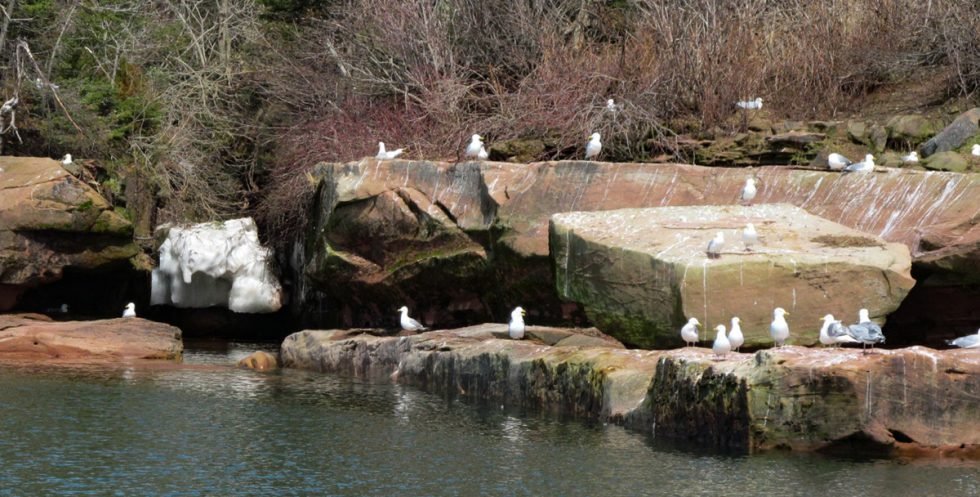
Eagle Island is one of the smaller and more remote islands in the Apostle Islands archipelago, characterized by its steep cliffs and rugged shoreline.
This secluded island offers a dramatic landscape that is markedly different from the more accessible islands in the group.
Its limited accessibility and wild nature make it a less frequented but incredibly rewarding destination for those who venture there.
Featuring Dramatic Overlooks and Eagles’ Nests
Dramatic Overlooks: The island’s geography features high cliffs that provide stunning overlooks onto Lake Superior. These natural vantage points offer breathtaking panoramic views of the surrounding waters and other islands in the archipelago. The cliffs are a favorite spot for photographers and nature lovers who seek out the dramatic landscapes that epitomize the wild beauty of the Apostle Islands.
Eagles’ Nests: True to its name, Eagle Island is a known habitat for bald eagles, who often build their nests in the tall trees that cling to the cliffs. These majestic birds can frequently be seen soaring above the island or perched in their lofty nests. The presence of eagles adds to the island’s wild allure, providing visitors with the chance to observe these magnificent birds in their natural setting.
Accessing Eagle Island: Due to its remote location and challenging terrain, Eagle Island is best visited by those who are experienced in navigating rough waters and rugged landscapes. Access is typically by private boat, and visitors are encouraged to maintain a safe distance from the shoreline to avoid disturbing the wildlife, particularly during nesting season. The island is subject to access restrictions to protect the sensitive eagle population and other wildlife, so it’s important for visitors to check with the National Park Service for any current advisories or regulations before planning a visit.
15. Quarry Bay
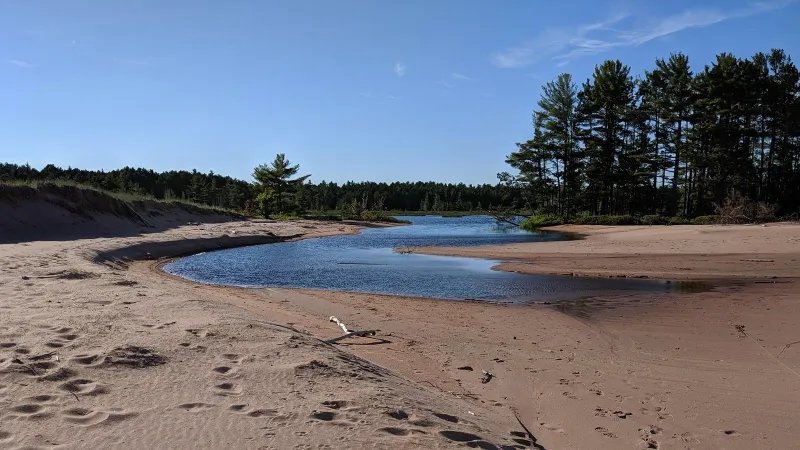
Quarry Bay on Stockton Island is a site steeped in both natural beauty and historical significance within the Apostle Islands National Lakeshore.
Known for its calm waters and sheltered location, Quarry Bay provides a serene setting that contrasts with the often rugged and windswept shorelines found elsewhere in the archipelago.
This bay is particularly appealing for its accessible beaches and as a starting point for exploring the island’s interior.
Historical Quarry Operations and Diving Sites
Historical Quarry Operations: The name “Quarry Bay” derives from its history as a site for sandstone quarrying, which took place in the late 19th and early 20th centuries. The sandstone from this area was highly prized for its quality and was used in building construction around the region. Visitors to Quarry Bay can still see remnants of these old quarry operations, including pieces of cut stone and old tools left behind, which tell the story of the island’s contribution to the building industry.
Diving Sites: The underwater topography near Quarry Bay also reflects its quarrying past, with submerged stone cuts and blocks creating unique underwater landscapes. These features, along with the clear waters of Lake Superior, make the area a popular spot for diving enthusiasts. Divers can explore the underwater ruins and natural formations, which serve as habitats for a variety of aquatic life. The combination of historical artifacts and natural underwater features offers a fascinating dive experience that is rich in both history and ecology.
Visiting Quarry Bay: Quarry Bay is accessible by boat, with mooring options available for those who wish to explore the area extensively. It is advisable for visitors to be mindful of the potential underwater hazards, especially near old quarry sites, and to follow safe diving practices. The bay’s beaches also offer more relaxed activities such as swimming and picnicking, making it a versatile destination for different types of visitors.
16. Little Sand Bay

Little Sand Bay is a gateway to the northern reaches of the Apostle Islands, offering more than just access—it’s a destination in its own right.
Nestled on the mainland, this area serves as a crucial launch point for adventures into the Apostle Islands, but also offers its own array of attractions, including a beautiful beach, camping facilities, and scenic picnic areas.
The bay’s calm waters and the well-maintained park facilities make it a family-friendly spot, perfect for a day trip or an extended stay.
Access Point and Visitor Center
Access Point: Little Sand Bay is an essential access point for visitors looking to explore the Apostle Islands by water. It features a full-service marina with boat launch facilities, making it an ideal starting point for boaters and kayakers. In addition, the bay offers kayak and boat rentals for those who don’t bring their own, complete with safety briefings and route suggestions for exploring the nearby islands.
Visitor Center: The Little Sand Bay Visitor Center serves as an educational and informational hub for guests. The center provides comprehensive resources about the Apostle Islands, including maps, historical exhibits, and interactive displays that highlight the natural and cultural history of the area. Staffed by knowledgeable park rangers, the visitor center offers guided programs and educational talks during the summer months, making it a valuable resource for first-time visitors and seasoned explorers alike.
Additional Facilities: Beyond its role as an access point, Little Sand Bay includes well-equipped camping sites that cater to both tent campers and RV travelers. The campground is set in a picturesque location with easy access to the beach and hiking trails, ensuring that visitors can enjoy the natural beauty of the area comfortably. Picnic areas and restrooms are also available, enhancing the bay’s appeal as a perfect spot for a leisurely day out in nature.
17. Basswood Island
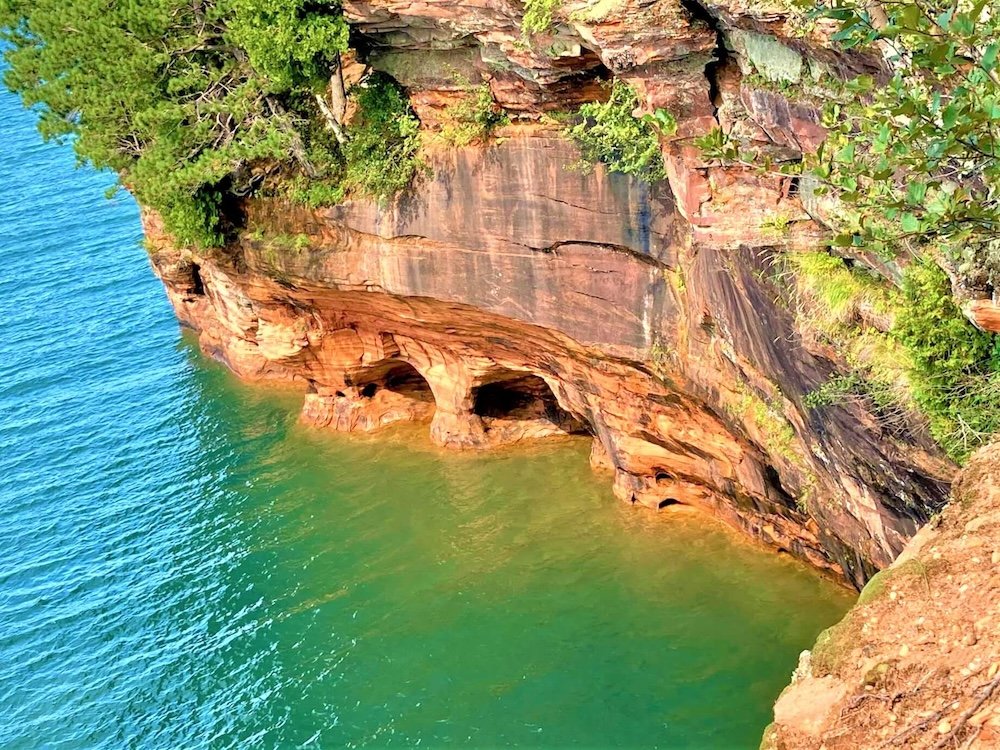
Basswood Island, one of the closer islands to the mainland within the Apostle Islands National Lakeshore, combines natural beauty with a rich tapestry of history.
This island is less frequented by tourists compared to others like Madeline Island or Sand Island, offering a quieter experience.
Its varied landscape features dense woodlands, rocky shores, and open fields, providing a diverse environment for hiking, wildlife watching, and exploring.
Historical Loops and Orchards
Historical Loops: Basswood Island boasts several historical walking loops that take visitors through areas of historical significance across the island. These trails are not just pathways through nature but journeys through time. They pass by old farmstead sites, historic logging areas, and remnants of past settlements. Interpretative signs along these loops provide context about the island’s past uses and the people who lived and worked there, enriching the hiking experience with educational insights.
Orchards: One of the unique features of Basswood Island is its historic orchards, which are remnants of the agricultural past of the island. These orchards, some still bearing fruit, were planted by settlers in the 19th century and have been maintained to this day. During the fall, these orchards offer a picturesque scene with their bounty of apples and a sweet aroma that fills the air. Visitors can explore these orchards, learning about historic agricultural practices in the region, and enjoy the serene beauty of these cultivated natural spaces.
Visiting Basswood Island: Access to Basswood Island is primarily by boat, with options for docking at one of the small piers on the island or anchoring offshore. The island’s proximity to the mainland makes it an easy day trip, but there are also a few rustic campsites for those wishing to extend their stay. Whether you are a history buff, nature enthusiast, or just looking for a peaceful spot to relax, Basswood Island offers a quiet refuge with a fascinating historical backdrop.
18. Hermit Island
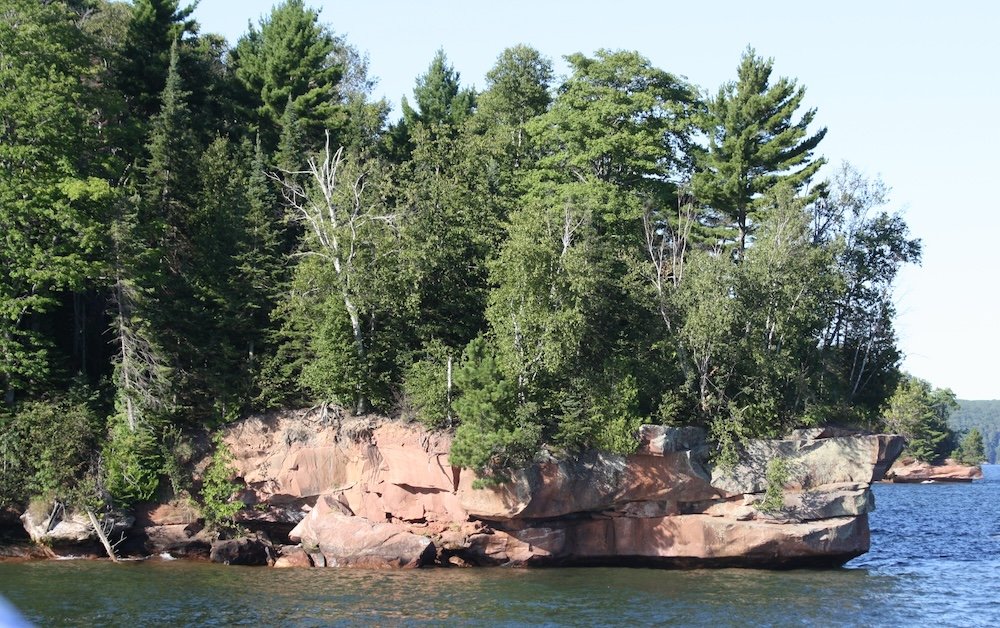
Hermit Island, often enshrouded in the mystique of its name, is a smaller and less visited island in the Apostle Islands archipelago.
Its rugged coastline, dense forests, and secluded beaches offer a perfect backdrop for solitude and reflection.
The island’s remote nature and minimal human impact make it an ideal spot for those seeking a deeper connection with nature away from the bustling tourist paths.
Mystique of Past Hermit Residents
Past Hermit Residents: The island’s intriguing name, Hermit Island, derives from its history of being the home to various hermits who sought solitude in its secluded environment. The most famous of these was a man known as “The Hermit of Hermit Island,” who lived there during the early 20th century. His story, and those of others like him, contribute to the island’s aura of mystery and solitude. These individuals chose the island as a place to live in near total isolation, interacting minimally with the outside world, and living off the land in what many would consider extreme conditions.
Exploring the Hermit’s Legacy: Visitors to Hermit Island can explore the remnants of the hermit dwellings and artifacts left behind, which are subtly integrated into the landscape. Hiking trails lead to these historic sites, where interpretive signs provide context and stories about the lives of the island’s former inhabitants. This exploration not only offers a physical adventure but also a window into the unique human history that colors the island’s past.
Visiting Hermit Island: Access to Hermit Island is primarily by private boat, with moorings along the shore for those who wish to explore on foot. The island’s untouched natural beauty and historical intrigue make it a compelling destination for kayakers and boaters skilled enough to navigate its shores. Visitors are encouraged to respect the quietude and pristine condition of the island, maintaining its integrity as a sanctuary for wildlife and a haven for reflective solitude.
19. York Island
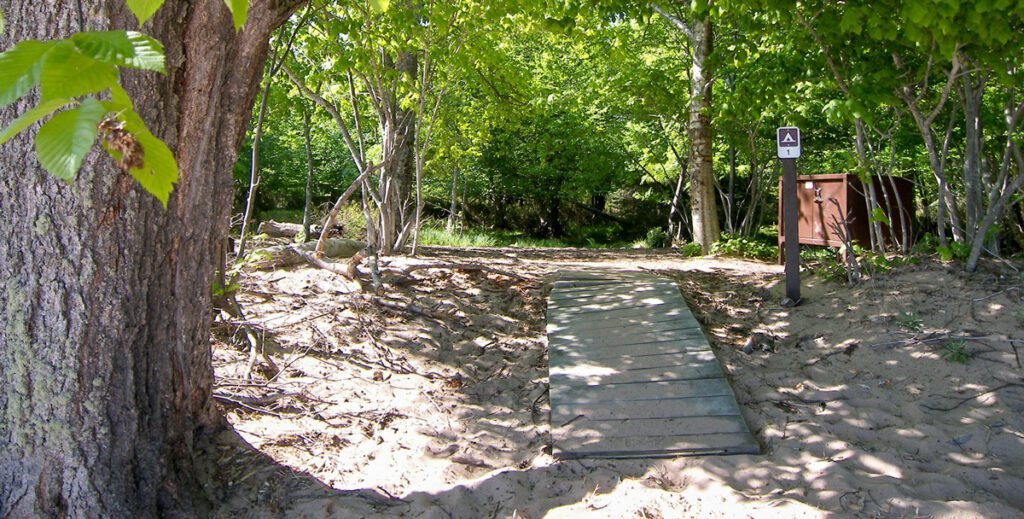
York Island is one of the smaller islands within the Apostle Islands National Lakeshore, offering a compact but richly rewarding natural environment.
Its modest size belies the diversity of landscapes found within, from dense woodland areas to rugged shorelines.
York Island provides a quieter, more intimate experience compared to some of the larger islands, making it a favored spot for those looking to escape into nature without straying too far from the main access points.
Small-Scale Camping and Pristine Nature
Small-Scale Camping: York Island features a few small, well-maintained campsites that are ideal for visitors seeking a low-impact camping experience. These sites offer basic amenities such as fire rings and pit toilets, emphasizing a “leave no trace” approach to ensure the preservation of the island’s natural state. The limited number of campsites helps maintain the quiet and solitude that are characteristic of York Island, providing a personal and close-to-nature camping experience.
Pristine Nature: The island’s untouched natural beauty is its main attraction. York Island’s trails meander through a variety of ecosystems, offering easy to moderate hikes with beautiful views of Lake Superior. The shorelines provide opportunities for wildlife viewing, including bird watching and occasional sightings of larger mammals like deer. The island’s clear waters are also perfect for kayaking and canoeing, allowing for a gentle exploration of its coastal features.
Accessing York Island: Access to York Island is typically by boat, with options to anchor offshore. This accessibility makes it a popular day-trip destination from nearby points like Bayfield or Red Cliff. For those planning to camp, reservations are recommended during peak season to secure a site, as their number is limited and they are quite popular among those in the know.
20. Rocky Island
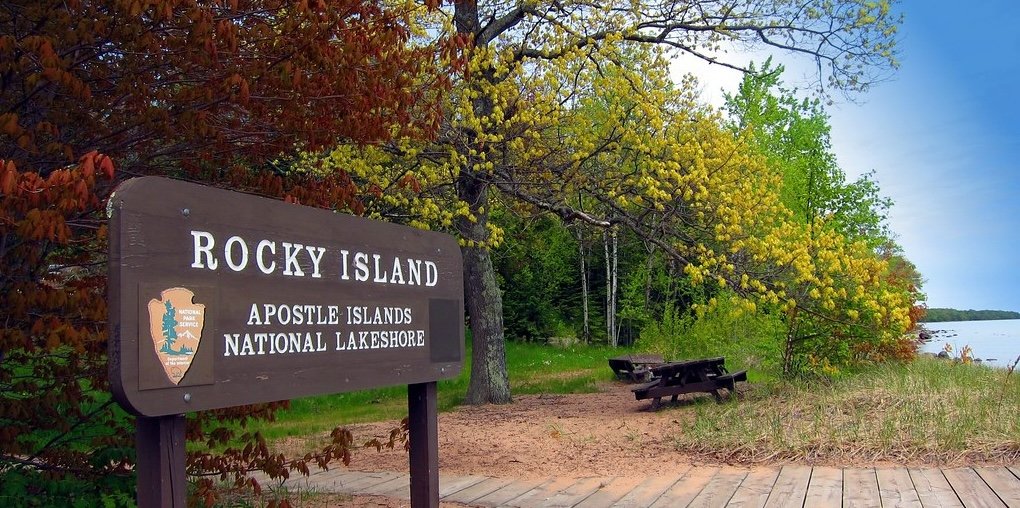
Rocky Island, true to its name, features rugged coastlines and rocky outcroppings that create a dramatic and picturesque landscape within the Apostle Islands National Lakeshore.
While it may not be as large or well-known as some of its neighbors, Rocky Island offers its own unique charm and opportunities for exploration.
Its rocky shores, combined with dense forests and stunning vistas, make it a hidden gem for those seeking a secluded and adventurous island experience.
Late-Season Camping and Historic Sites
Late-Season Camping: Rocky Island is an excellent destination for late-season camping, offering a quieter and more intimate experience as the summer crowds dissipate. The island’s campsites, though basic, provide a comfortable base for exploring its rugged terrain and taking in the crisp autumn air. Late-season camping also offers the chance to witness the changing colors of the surrounding forests, adding another layer of beauty to the island’s landscape.
Historic Sites: In addition to its natural attractions, Rocky Island is home to several historic sites that offer a glimpse into the island’s past. These include remnants of old logging camps and fishing stations, which speak to the island’s history of human habitation and resource utilization. Exploring these historic sites adds depth to the visitor experience, connecting them with the island’s rich heritage and the people who once called it home.
Accessing Rocky Island: Access to Rocky Island is primarily by private boat or kayak, with options for anchoring or beaching along its shores. Due to its relatively remote location and limited facilities, visitors should come prepared with all necessary supplies, including food, water, and camping gear. Late-season visitors should also be mindful of changing weather conditions and plan accordingly for their safety and comfort.
Conclusion
The Apostle Islands National Lakeshore is a treasure trove of natural beauty, historical significance, and outdoor adventure.
From the dramatic sea caves of the mainland to the secluded beaches of the outer islands, each spot within this archipelago offers its own unique charm and opportunities for exploration.
Visitors can hike through old-growth forests, kayak along rocky shorelines, and immerse themselves in the rich cultural history of the region.
Visiting the Apostle Islands is more than just a vacation—it’s an opportunity to connect with nature in its purest form.
Whether you’re camping under the stars, exploring historic sites, or simply taking in the breathtaking views, there’s something magical about being surrounded by the pristine beauty of Lake Superior.
The islands offer a chance to escape the hustle and bustle of everyday life and experience a sense of peace and tranquility that can only be found in the great outdoors.

FAQ’s About the Apostle Islands:
Are Apostle Islands worth visiting?
Absolutely! The Apostle Islands offer a breathtaking blend of natural beauty, rich history, and outdoor adventure that make them well worth a visit.
From the stunning sea caves and pristine beaches to the hiking trails and wildlife viewing opportunities, there’s something for everyone to enjoy on these picturesque islands.
What is special about Apostle Islands?
The Apostle Islands are renowned for their unique blend of natural beauty and cultural history.
From the striking sea caves and sandstone cliffs to the rich Native American heritage and historic lighthouses, each aspect of the islands holds its own special charm.
Whether you’re exploring by kayak, hiking the trails, or simply relaxing on the beach, there’s no shortage of unforgettable experiences to be had in this one-of-a-kind destination.
Can you stay on any of the Apostle Islands?
While there are no lodging options directly on the islands themselves, there are several campgrounds available for visitors looking to stay overnight.
Additionally, there are numerous lodging options available in nearby towns such as Bayfield, where visitors can stay and easily access the islands via ferry or private boat.
How long is the ferry ride to the Apostle Islands?
The ferry ride to the Apostle Islands varies depending on the departure point and destination within the archipelago.
Generally, ferry rides from Bayfield to popular destinations like Madeline Island take around 25-30 minutes, while longer excursions to outer islands may take up to an hour or more.
What is the best month to visit the Apostle Islands?
The best time to visit the Apostle Islands depends on your preferences and interests.
Summer months, particularly July and August, tend to be the most popular for outdoor activities and exploring the islands’ natural beauty.
However, shoulder seasons like late spring and early fall offer fewer crowds and cooler temperatures, making them ideal for hiking and wildlife viewing.
What city is closest to Apostle Islands?
The city closest to the Apostle Islands is Bayfield, Wisconsin. Located on the shores of Lake Superior, Bayfield serves as the gateway to the islands and offers a variety of amenities for visitors, including lodging, dining, and recreational activities.
Where should I stay to see the Apostle Islands?
For easy access to the Apostle Islands, Bayfield is the best place to stay.
This charming lakeside town offers a range of lodging options, including hotels, bed and breakfasts, and campgrounds, as well as convenient access to ferry services and other island activities.
Can you swim in the Apostle Islands?
Yes, swimming is a popular activity in the Apostle Islands, especially during the summer months when temperatures are warmer.
However, it’s important to note that Lake Superior’s waters can be cold and conditions can change rapidly, so visitors should exercise caution and be aware of potential hazards such as strong currents and undertows.
How do you get around the Apostle Islands?
The primary modes of transportation around the Apostle Islands are by boat and foot.
Many visitors choose to explore the islands by kayak or private boat, allowing for flexibility and access to remote areas.
Once on the islands, hiking trails provide opportunities for exploring on foot, with some islands also offering bike rentals for further exploration.
Additionally, guided tours and water taxis are available for those looking for a more structured way to see the sights.
